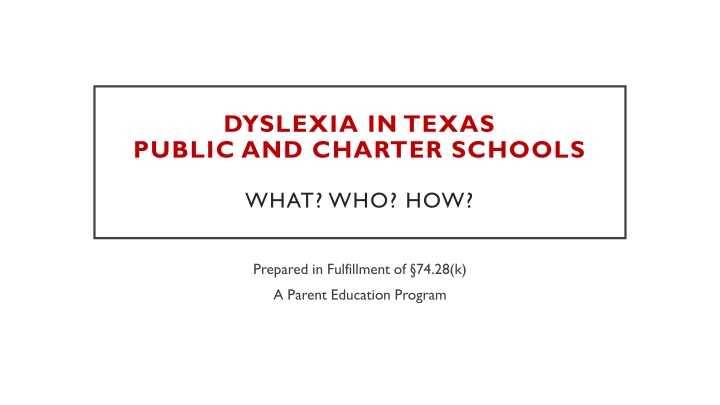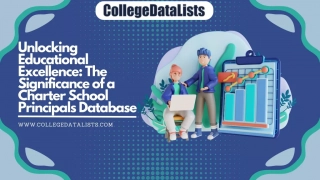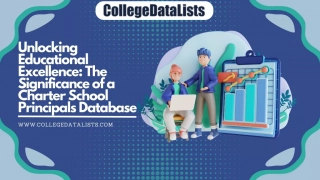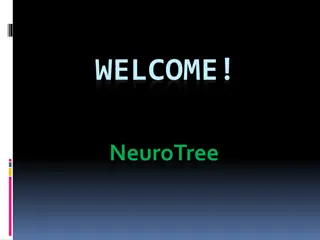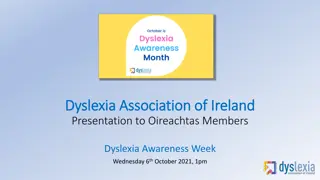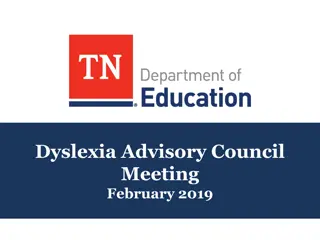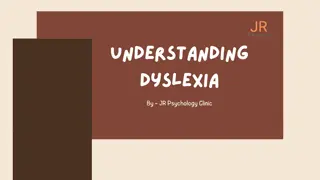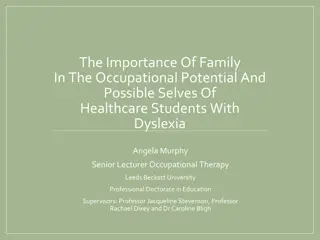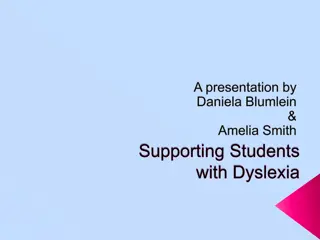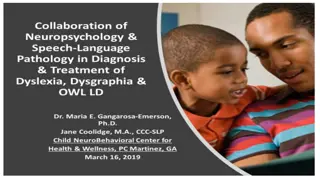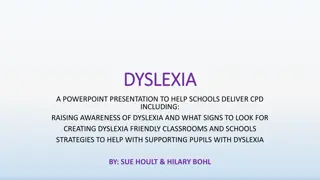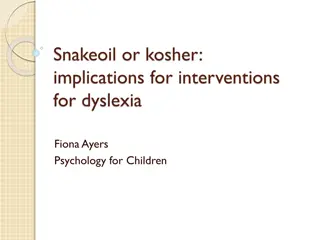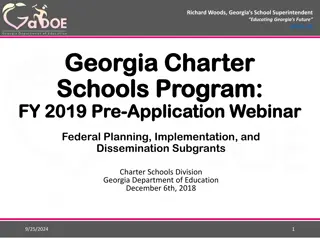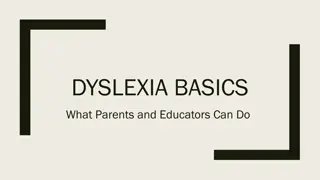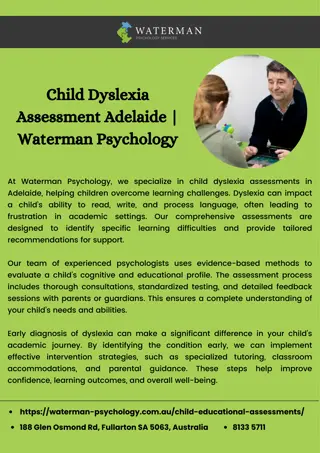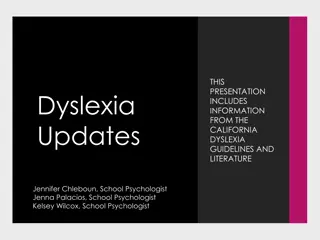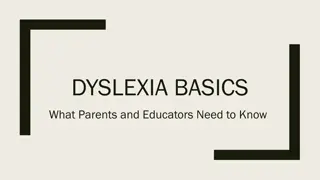Dyslexia in Texas Public and Charter Schools
Acquired skill, reading is a complex process involving word recognition, fluency, and comprehension. Dyslexia presents difficulties recognizing words, with possible impacts on reading comprehension and spelling. Common risk factors include issues with rhyming, alphabet learning, and phonics application. This content discusses dyslexia, its traits, impacts, and associated risk factors.
Download Presentation

Please find below an Image/Link to download the presentation.
The content on the website is provided AS IS for your information and personal use only. It may not be sold, licensed, or shared on other websites without obtaining consent from the author.If you encounter any issues during the download, it is possible that the publisher has removed the file from their server.
You are allowed to download the files provided on this website for personal or commercial use, subject to the condition that they are used lawfully. All files are the property of their respective owners.
The content on the website is provided AS IS for your information and personal use only. It may not be sold, licensed, or shared on other websites without obtaining consent from the author.
E N D
Presentation Transcript
DYSLEXIA IN TEXAS PUBLIC AND CHARTER SCHOOLS WHAT? WHO? HOW? Prepared in Fulfillment of 74.28(k) A Parent Education Program
WHAT IS READING? An acquired skill, not a natural development A gradual process that starts in infancy
WHAT IS READING? A complex process of making meaning from print Identifying or figuring out (decoding) words Making meaning from them Coordinating those two steps Reading Fluency Word recognition Comprehension
WHAT IS DYSLEXIA? Difficulty recognizing words Possible impact on reading comprehension Trouble decoding words Specific Learning Disability Slow, inaccurate oral reading Phonology struggles / deficits Spelling issues
WHAT ELSE? Often runs in families Is neuro- biological Look for cluster of traits Can differ in degree of impact
COMMON RISK FACTORS ASSOCIATED WITH DYSLEXIA Note: Exhibited reading behaviors may change with age and grade. Difficulty with oral language Delay in learning to talk Persistent baby talk Difficulty with rhyming Trouble pronouncing words or recalling the right word when speaking Problems with learning the alphabet, letter names, and corresponding sounds Issues with identifying and manipulating individual sounds in words Difficulty with reading Guessing at words or relying on pictures Trouble with recognizing common sight words Struggles with recalling the correct sounds for letters and letter patterns Fluency difficulty [reading may be slow, inaccurate, and/or without expression] Difficulty applying phonics to figure out unfamiliar words
OTHER COMMON RISK FACTORS Difficulty with spelling Trouble remembering the sounds that letters or letter patterns represent May omit letters in words [ after spelled eftr ] May do well on weekly spelling tests but then makes many spelling errors in daily work Consistently misspells common irregular words [they, could, said] Finds homophones confusing [their, there, they re] May reverse, transpose, or rotate letters Difficulty with writing Substitutes less-sophisticated words for those that may be harder to spell [ big instead of enormous ] Has problems with completing written assignments, especially longer ones May have good ideas but struggles to write them in an organized way Makes errors copying from the board or book Displays poor or illegible handwriting [sometimes to the point of not being able to reread own writing]
WHAT ELSE? MIGHT ALSO SEE Tendency to avoid reading (particularly for pleasure) Resistance to reading aloud Reliance on listening rather than reading for comprehension Frustration with amount of time required and energy expended for reading Difficulty with volume of reading and written work Trouble with notetaking Oral answers often better than written responses Struggle to finish tests on time Deflated self-esteem that can seem to be lack of motivation
Yes! ARE THERE ANY POSITIVES? Unexpected Difficulty Decoding
Dyslexia is a language-based learning disability. Dyslexia refers to a cluster of symptoms, which result in people having difficulties with specific language skills, particularly reading. Students with dyslexia usually experience difficulties with other language skills such as spelling, writing, and pronouncing words. Dyslexia affects individuals throughout their lives; however, its impact can change at different stages in a person s life. It is referred to as a learning disability because dyslexia can make it very difficult for a student to succeed academically in the typical instructional environment, and in its more severe forms, will qualify a student for special education, special accommodations, or extra support services. Dyslexia Basics, Just the Facts IDA Fact Sheet, 2017
WHERE CAN I LEARN MORE? Parent Resources https://tea.texas.gov/academics/dyslexia/ https://www.understood.org/en/learning-attention-issues/child- learning-disabilities/dyslexia/understanding-dyslexia Also https://www.bookshare.org/cms/ https://dyslexiaida.org/ https://learningally.org/ http://dyslexia.yale.edu/
RTI IDEA Section 504 p. 113 of Dyslexia Handbook Tiered intervention process designed to meet academic and behavior needs of all students Civil rights statute protecting students with disabilities from discrimination Funding law ensuring a free appropriate public education [FAPE] for students with disabilities who meet specific category requirements Ensures equal opportunity for eligible students when compared to nondisabled peers [FAPE] Interventions provided at increasing levels of intensity Provides services and supports specially designed to meet unique needs Also known as Special Education Progress monitoring informs instruction; data drives decision making Provides support and accommodations to meet individual needs through general education Parental notice required Parental consent required Parental consent required
WHAT IS INVOLVED IN A DYSLEXIA EVALUATION IN TEXAS? If a school or parent suspects the possibility of dyslexia, a team of knowledgeable persons, including the parents, would discuss data collected, its implications, and student need. All public-school students in kindergarten and Grade 1 must be screened for dyslexia [unless an ARD or Section 504 committee determines the screener is not appropriate or the student is already identified with dyslexia] . Also, Grade 2 students must be screened as must any Grade 7 student who did not pass STAAR reading the previous year. That data-based discussion could result in a referral under IDEA or Section 504 or continuation of tiered intervention. * Additionally, students enrolled in public schools must be evaluated for dyslexia and related disorders at appropriate times. [TEC 38.003(a)] Parents/guardians always have the right to request a referral for a dyslexia evaluation at any time. * See next slide for information on Pathways for Identification
WHAT ELSE? Gather Data Data shows no reason to suspect dyslexia, a related disorder, or other disability? No evaluation referral. Schools must recommend evaluation for dyslexia if the student demonstrates the following: Initial Evaluation Pathways Poor performance in one or more areas of reading and spelling that is unexpected for the student s age/grade Characteristics and risk factors of dyslexia Evaluation under 504 Evaluation under IDEA
IS IT DYSLEXIA? Identification made by appropriate committee Questions for Determining Dyslexia 1. Do the data show the following characteristics of dyslexia? o Difficulty with accurate and/or fluent word reading o Poor spelling skills o Poor decoding ability 2. Do these difficulties (typically) result from a deficit in the phonological component of language? 3. Are these difficulties unexpected for the student s age in relation to the student s other cognitive abilities and provision of effective classroom instruction? Academic skills assessed Letter knowledge Word reading and decoding Fluency Spelling Comprehension Additional considerations for EL students. Cognitive processes assessed Phonological skills Rapid naming skills No single test can be used to determine that a student has dyslexia.
Dyslexia Identified 504 Eligible? IDEA Eligible? Yes? Develop 504 Plan. Yes? Develop IEP. Standard Protocol Dyslexia Instruction Specially Designed Instruction
COMPONENTS OF DYSLEXIA INSTRUCTION The What 1. Phonological awareness Skill that includes identifying and manipulating units of oral language 2. Sound-symbol association Knowledge of how various speech sounds link with letters and letter combinations (usually taught with an explicit phonics approach) 3. Syllabication Knowledge of the six basic syllable types in English and syllable division rules 4. Orthography Understanding of the written spelling patterns and rules of English 5. Morphology Study of the structure and form of words in a language, including prefixes, suffixes, inflectional endings [like adding <s> to book to make it plural] 6. Syntax Study of the rules and patterns when writing grammatical sentences and phrases 7. Reading comprehension Understanding and interpreting what is read 8. Reading fluency Ability to read with appropriate rate, accuracy, and proper expression
DELIVERY OF DYSLEXIA INSTRUCTION The How Simultaneous and multisensory: Incorporates the use of two or more sensory pathways (auditory, visual, kinesthetic, tactile) at the same time Systematic and cumulative: Has a planned sequence of instruction that builds on itself Explicitinstruction: Focuses on clear explanations and modeling of key skills Diagnostic teaching to automaticity: Individualizes teaching for automaticity Synthetic instruction: Teaches how to blend sounds to create words Analytic instruction: Instructs how to break words down into component parts
PROVIDERS OF DYSLEXIA INSTRUCTION The Who Those providing dyslexia intervention for students are not required to hold a specific license or certification. However, they must at a minimum have additional documented training in dyslexia and related disorders as well as in the intervention curriculum being used.
__(SCHOOL NAME)________ DYSLEXIA PROGRAM Add your info
(SCHOOL NAME) DYSLEXIA TEACHERS AND THEIR TRAINING Add information here
THOUGHTS ON ACCOMMODATIONS Individualized The impact of dyslexia will vary with each student, so there is no one-size-fits-all approach. Examples Note-taking assistance Alternative test location to reduce distractions Word banks Audiobooks Formula charts Adaptive learning tools and features in software programs While the ARD or Section 504 committee will determine accommodations, students should be involved in their selection. Instruction is the first priority; not all classroom accommodations are allowed during a state assessment.
WHAT ARE RELATED DISORDERS? Disorders similar to or related to dyslexia Developmental Auditory Imperception Developmental Spelling Disorder Inability to receive and understand sounds and words Assessed by audiologists, speech-language pathologists Dysphasia Significant difficulty learning to spell, in the absence of reading difficulties Assessed by someone trained in dyslexia and the reading process Dysgraphia Inability to write legibly Assessed by someone trained in dyslexia and the reading process Chapter 5, Dyslexia Handbook Delay in development of comprehension and/or expression of oral language Assessed by speech-language pathologist
CONTACT INFORMATION District/ Campus R8 ESC Johnnie Freeman jfreeman@reg8.net 903-575-2796 Toll-free Dyslexia Hotline 1-800-232-3030
